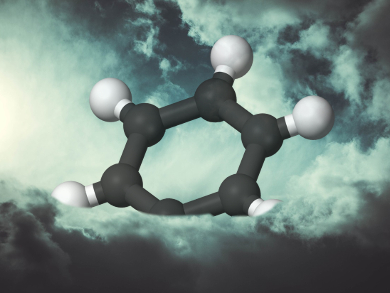Benzene as a Pollutant
Benzene is the archetype of aromatic stability, six carbon atoms, each with its attendant hydrogen atom, locked together in the familiar hexagonal array; quite the beautiful molecule. Unfortunately, in the years since Charles Mansfield, working under August Wilhelm von Hofmann, isolated benzene from coal tar and Friedrich August Kekulé published his Ouroboros-inspired vision of the cyclic nature of this endlessly fascinating molecule, much has come to be known of its role as a hazard to health and the environment.
Indeed, benzene is listed by the US Environmental Protection Agency (EPA) and other organizations as a carcinogen, a live toxin and more besides. It is one of a handful of ubiquitous atmospheric pollutants released into the air from industrial sites, biomass burning, solvent release and the exhaust fumes of the internal combustion engine. For now, at least, benzene is here to stay.
A Complex Multiphase System
However, despite its stability, hydroxyl radicals in both the gas and aqueous solution phases can react with benzene. Aubrey Heath and Kalliat Valsaraj of the Cain Department of Chemical Engineering at Louisiana State University in Baton Rouge, LA, USA, have looked closely at the role of the nanoscopic aerosol particles of water that pervade our atmosphere and are commonly known as fog to help to improve our understanding of the benzene lifecycle.
Atmospheric aerosols, which includes fog droplets, are complex, multiphase systems. Their presence in the atmosphere is determined by local weather conditions, time of day, temperature, pH and ionic strength, as well as air pressure. Nevertheless, they all have one thing in common: Due to their small size and high specific surface area, the interface between water and air has to be considered, not just the bulk properties. Reactions are dependent on the vast surface area represented by a volume of fog.
Simulating Benzene’s Reaction Kinetics in Atmospheric Fog
Heath and Valsaraj have studied the reaction kinetics of benzene and hydroxyl radicals in a thin-film flow-tube reactor to simulate fog droplets, using a photoreactor and liquid chromatography mass spectrometry (LC-MS) grade water to form their “fog” films. The team measured the rate of phenol (“hydroxybenzene”) formation with different film thicknesses and observed interfacial rate constants that were four to five times higher than those known for the reaction of benzene with hydroxyl radicals in the bulk phase. Moreover, the thinner the film (and so the closer it resembles a fog droplet), the more rapid the reaction.
The team points out that this effect may be even greater for polyaromatic hydrocarbons (PAHs), a group of chemical cousins of benzene which are just as ubiquitous in the atmosphere. The findings, therefore, have significant implications for the formation of reactive species from otherwise stable pollutants in a foggy atmosphere, particularly under ultraviolet irradiation from the sun.
Conversely, the team points out that the rate enhancement they observed in their thin film flow reactions system might also be exploited by chemists in the laboratory or industry for the physical catalysis of desirable reactions without recourse to large surface area metal catalysts or the dissolution of catalyst and reagents in bulk solution solvent. This could save the attendant separation and retrieval costs and inefficiencies inherent in those more conventional approaches to speeding up reactions.
The Next Steps
“The next step in the study is to try and extend this to compounds other than benzene that might be particularly susceptible to so-called ‘atmospheric processing’ by fog”, Valsaraj told ChemViews Magazine.
“Benzene is a highly toxic pollutant, and is mainly removed in the gas phase by reaction with OH radicals in the atmosphere,” atmospheric chemist Dwayne Heart of Leeds University, UK, explains. However, “little attention has been paid to this removal on aqueous surfaces”. He points out that in this study, it seems that the rate of reaction between OH and benzene is accelerated dramatically at the surface, with the rate increasing dramatically as the film thickness decreases. He explains further that, “Although most of the interfacial chemistry in the atmosphere will take place on the surface of fog/aerosol particles, this flow-tube aqueous film reactor does enable the enhancement of the reaction rate on a model aqueous surface to be investigated”.
Heard theorizes that, “The enhancement could be due to either interfacial or bulk contributions, but the researchers have analyzed the data to show that the interfacial contribution to the rate enhancement is highly dominant.” He also adds that it would be interesting to look at the atmospheric impact of these measurements in terms of the reduction of the lifetime of benzene owing to these interfacial processes, which could be significant but not yet included in atmospheric models, and also the additional production of the product phenol. “Polyaromatic hydrocarbons (PAHs) are linked benzene rings, and an important, persistent but poorly understood carcinogen in the atmosphere, and extending this type of study to PAHs would be very worthwhile”, he adds. “It would also be important to extend this type of study to more realistic interfacial environments such as the surfaces of aerosol or fog particles.”
- Effects of Temperature, Oxygen Level, Ionic Strength, and pH on the Reaction of Benzene with Hydroxyl Radicals at the Air–Water Interface in Comparison to the Bulk Aqueous Phase,
Aubrey A. Heath, Kalliat T. Valsaraj,
J. Phys. Chem. A 2015.
DOI: 10.1021/acs.jpca.5b05152




